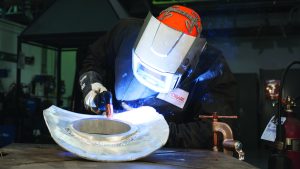Based on an article by SEAN WALKOWSKI, AWS Magazine, January 2024
Successful aluminum gas metal arc welding (GMAW) hinges on meticulous attention to detail and a foundational understanding. Taking preventive measures to sidestep usual errors is crucial to minimize downtime for troubleshooting.
Aluminum GMAW demands thorough attention to detail and foundational knowledge for efficacy. It’s crucial to implement preventive measures to avert typical errors that could necessitate downtime for troubleshooting and compromise the weld’s integrity.
Usual challenges encompass feedability issues due to the aluminum welding wire’s softness, which may worsen if the welding gun is coiled by the operator or if the drive rolls are overtightened. Insufficient cleaning and leaks in the shielding gas can cause porosity. Additionally, melt-through on thinner material sections and incomplete fusion on thicker ones are possible if inappropriate settings or techniques are used by the welder.
Beginners in aluminum welding should be aware of the necessary cleaning protocols, proper setup of drums or spools, suitable equipment usage, and more.
Guidelines for Effective Setup
Preparing for aluminum GMAW involves scrutinizing each component of the welding system. Each component has its specifications, and adhering to best practices is advised.
Spools and Drums
Installing spools is usually straightforward. Occasionally, a tangle might happen during attachment to the wire feeder, but this can be resolved by detaching the spool and unwinding a couple of layers. Support the spool from beneath and position it on the spool assembly, ensuring alignment with the dowel on the feeder. Secure it with the retaining clip.
Configuring an aluminum welding wire drum is time-consuming and requires expertise due to the potential flipping of the wire as it is drawn from the drum. Adhering to manufacturer-specific drum setup instructions is essential. Different aluminum alloys might need unique drum-feeding mechanisms. A spinning device inside the drum is typically necessary for a 4XXX series filler, whereas a 5XXX series filler might only need a directing ring or cone.
All conduits from the drum to the feeder must be straight for optimal wire feeding. Turns in the conduit should have a broad radius to allow twists to pass smoothly. Correct conduit length is important to avoid any pathway obstructions.
Wire Feeder and Welding Drive Rolls
Some wire feeders for aluminum GMAW feature electric brakes to prevent overspooling. Others include a hub tensioner that increases resistance as it is tightened. This tension should be minimal yet sufficient to stop the spool when the feeder ceases pulling.
Always opt for U-groove welding drive rolls when handling aluminum because of the metal’s softness. Setting the drive roll pressure at a minimum helps prevent wire distortion or shaving. A simple test to check tension involves allowing the wire to coil into a 2- to 3-inch diameter in a gloved hand; adjustments are needed if the coil diameter is too small.
Welding Gun and Consumables
Push-pull guns are preferred for aluminum GMAW due to their reliable feedability, especially when used with nylon or plastic liners that prevent wire shaving. Spool guns are less costly alternatives suitable for smaller tasks but require frequent wire changes. Some operations opt for standard push welding systems with thicker wires and shorter cables, requiring careful preparation of the steel liners to avoid shaving problems.
Specific polished contact tips with a bore diameter roughly 10 to 15% larger than the wire are essential for aluminum GMAW to prevent issues like meltback.
Power Sources, Parameters, and More
Any direct current electrode positive (DCEP) power source is suitable for aluminum welding. For thin aluminum sections, consider a power source with pulsed welding features to reduce the risk of melt-through.
Setting the welding parameters for aluminum GMAW varies by application and involves considerations like wire speed, amperage, voltage, and travel speed. Differences in electrical conductivity between aluminum series impact these settings. Starting points for settings can often be found on filler metal spec sheets.
The standard shielding gas for aluminum GMAW is 100% argon, offering consistent shielding and cost-effectiveness. An argon/helium mix might be used for thicker aluminum to enhance the arc’s heat and reduce porosity risks.
Attention to Cleanliness
Ensuring all components of the aluminum GMAW process are clean is crucial for optimal results. Preventing moisture buildup, using solvents for degreasing, and employing dedicated wire brushes for aluminum are key steps in the cleaning process.
Finally, employ a stainless steel wire brush specifically for cleaning aluminum to help avoid porosity. This brushing is essential for eliminating the aluminum oxide layer on the aluminum’s surface. It’s advisable to brush in a single direction to avoid embedding impurities. While some welders favor power tools over manual wire brushes, these tools should be used with low pressure and at low speeds. An electric die grinder is preferable to a pneumatic tool, as the latter’s exhaust may release small oil droplets that could pollute the base material.
Achieving Optimal Outcomes
Attentive setup and adherence to recommended practices for aluminum GMAW can lead to successful outcomes. Being diligent about all aspects of the setup and following manufacturer guidelines for equipment and filler metals are fundamental for achieving quality welds.
Original article: https://www.aws.org/magazines-and-media/magazine-and-journal/welding-journal/wj-jan-24-feature-05-walkowski-hobart/


